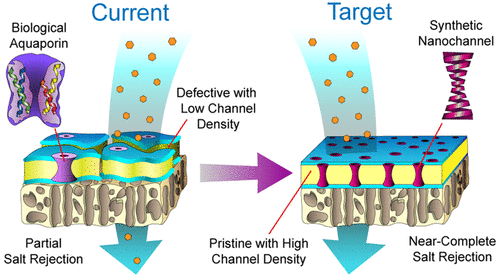Our official English website, www.x-mol.net, welcomes your feedback! (Note: you will need to create a separate account there.)
Pathways and Challenges for Biomimetic Desalination Membranes with Sub-Nanometer Channels.
ACS Nano ( IF 17.1 ) Pub Date : 2020-09-04 , DOI: 10.1021/acsnano.0c05753 Cassandra J Porter 1 , Jay R Werber 1, 2 , Mingjiang Zhong 1 , Corey J Wilson 3 , Menachem Elimelech 1
ACS Nano ( IF 17.1 ) Pub Date : 2020-09-04 , DOI: 10.1021/acsnano.0c05753 Cassandra J Porter 1 , Jay R Werber 1, 2 , Mingjiang Zhong 1 , Corey J Wilson 3 , Menachem Elimelech 1
Affiliation

|
Transmembrane protein channels, including ion channels and aquaporins that are responsible for fast and selective transport of water, have inspired membrane scientists to exploit and mimic their performance in membrane technologies. These biomimetic membranes comprise discrete nanochannels aligned within amphiphilic matrices on a robust support. While biological components have been used directly, extensive work has also been conducted to produce stable synthetic mimics of protein channels and lipid bilayers. However, the experimental performance of biomimetic membranes remains far below that of biological membranes. In this review, we critically assess the status and potential of biomimetic desalination membranes. We first review channel chemistries and their transport behavior, identifying key characteristics to optimize water permeability and salt rejection. We compare various channel types within an industrial context, considering transport performance, processability, and stability. Through a re-examination of previous vesicular stopped-flow studies, we demonstrate that incorrect permeability equations result in an overestimation of the water permeability of nanochannels. We find in particular that the most optimized aquaporin-bearing bilayer had a pure water permeability of 2.1 L m–2 h–1 bar–1, which is comparable to that of current state-of-the-art polymeric desalination membranes. Through a quantitative assessment of biomimetic membrane formats, we analytically show that formats incorporating intact vesicles offer minimal benefit, whereas planar biomimetic selective layers could allow for dramatically improved salt rejections. We then show that the persistence of nanoscale defects explains observed subpar performance. We conclude with a discussion on optimal strategies for minimizing these defects, which could enable breakthrough performance.
中文翻译:

具有亚纳米通道的仿生淡化膜的途径和挑战。
跨膜蛋白通道,包括负责快速选择性水传输的离子通道和水通道蛋白,已经激发了膜科学家开发和模仿其在膜技术中的性能。这些仿生膜包含在坚固的载体上在两亲性基质内排列的离散纳米通道。虽然直接使用了生物成分,但也进行了广泛的工作以产生稳定的蛋白质通道和脂质双层的合成模拟物。但是,仿生膜的实验性能仍然远远低于生物膜。在这篇综述中,我们严格评估了仿生淡化膜的状态和潜力。我们首先回顾一下渠道化学及其运输行为,确定关键特性以优化水的渗透性和脱盐率。考虑到运输性能,可加工性和稳定性,我们在工业环境中比较了各种渠道类型。通过重新检查以前的囊泡止流研究,我们证明不正确的渗透率方程会导致高估纳米通道的水渗透率。我们特别发现,最优化的含水通道蛋白的双层膜的纯水渗透率为2.1 L m–2 h –1 bar –1,与目前最先进的聚合物脱盐膜相当。通过对仿生膜形式的定量评估,我们分析表明,包含完整囊泡的形式提供的益处最小,而平面仿生选择性层可以显着改善除盐率。然后,我们表明纳米级缺陷的持久性可以解释所观察到的性能欠佳。最后,我们讨论了将这些缺陷减到最少的最佳策略,这可以实现突破性的性能。
更新日期:2020-09-22
中文翻译:

具有亚纳米通道的仿生淡化膜的途径和挑战。
跨膜蛋白通道,包括负责快速选择性水传输的离子通道和水通道蛋白,已经激发了膜科学家开发和模仿其在膜技术中的性能。这些仿生膜包含在坚固的载体上在两亲性基质内排列的离散纳米通道。虽然直接使用了生物成分,但也进行了广泛的工作以产生稳定的蛋白质通道和脂质双层的合成模拟物。但是,仿生膜的实验性能仍然远远低于生物膜。在这篇综述中,我们严格评估了仿生淡化膜的状态和潜力。我们首先回顾一下渠道化学及其运输行为,确定关键特性以优化水的渗透性和脱盐率。考虑到运输性能,可加工性和稳定性,我们在工业环境中比较了各种渠道类型。通过重新检查以前的囊泡止流研究,我们证明不正确的渗透率方程会导致高估纳米通道的水渗透率。我们特别发现,最优化的含水通道蛋白的双层膜的纯水渗透率为2.1 L m–2 h –1 bar –1,与目前最先进的聚合物脱盐膜相当。通过对仿生膜形式的定量评估,我们分析表明,包含完整囊泡的形式提供的益处最小,而平面仿生选择性层可以显着改善除盐率。然后,我们表明纳米级缺陷的持久性可以解释所观察到的性能欠佳。最后,我们讨论了将这些缺陷减到最少的最佳策略,这可以实现突破性的性能。



























 京公网安备 11010802027423号
京公网安备 11010802027423号